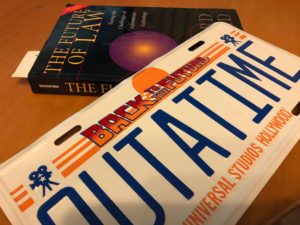A friend of mine commenting on their work situation last year used a phrase that chimed with me at little, they said referring to their job that they’d “lost their mojo”. For me it was a feeling that Legal IT had lost that something that it had, the reason I really liked working in this sector as opposed to say the utilities industry I’d started in, what was it? Was it the endless talk of AI, big data, blockchain…..how many years have we been talking about these now? Was the legal industry of the late 90’s just more exciting?
Well I knew a place to start looking, I’d revisit the classic “The Future of Law” by Richard Susskind (revised 1998 edition) a book that every IT person in the industry back then had on the bookshelf.
In this first post I’m going to look at ten of the “likely developments in IT over the next ten years” according to Mr Susskind in 1998.
- Global telecommunications – great start with the predictions here and a big tick, this was pretty much spot on. Richard predicted a global telecoms infrastructure that would “enable the instantaneous transmission of seemingly limitless amounts of digital information at negligible cost”. Given I’m typing this directly into the cloud whilst listening to music streamed from somewhere other than my PC, I’d say conclusive evidence.
- Information industries – basically this was the idea that we’d have systems that led us through complex issues on a question and answer basis, domestic examples he gave were online booking! So another tick then. I mean this can anyone imagine not conducting a transaction this way anymore?
- Virtual private networks – not VPN’s as we know now, but walled off restricted parts of the internet. The concept has been achieved with specific communities and sites, but perhaps not in the way thought at the time with walled off networks. So yes think this is a tick as the concept has come to fruition.
- Computing power – “holographic memory”, maybe not specifically but the promise of capacity way beyond DVD’s certainly achieved. Also “such that credit card sized machines more powerful than any PC of today with detachable, slim-line screens are entirely conceivable within the next ten years or so”, iPhone anyone?
- Convergence of computers and television – need I say anymore on this one!
- Smarter Technology – now I’m going to come back to this one in a later post, but let’s just pluck two words from the section “artificial intelligence” and think Hmmm.
- Multi-media – this section was on the move from print to digital. Another big tick, from Kindles to online newspapers and magazines, we’re definitely digital first nowadays.
- Usability – “continuous speech systems will be widely used within five years” so 2003. The concepts of voice, augmented reality and customised interfaces are mentioned. The latter has changed with the advent of the app and the touchscreen, but we’re still nowhere near in the others if we’re honest!
- Interpersonal and interorganisational computing – “groupware – a category of system and software specifically designed to encourage and enable collaborative, interpersonal and interorganisational activity”. So like Facebook, Microsoft Teams, Slack etc? Tick.
- The Web as the “first port of call” – “will become as commonplace as the telephone and the television”, well given it’s supplanted them both you can’t argue with that!
So pretty good to be fair, given the difficulty in predictions within IT it’s actually very good. Sets things up nicely for me to start to pick at some of the sections later in the book that look at some specific Legal IT areas, areas that I think Richard Susskind got right (similar to above) it’s just, well you’ll see!



